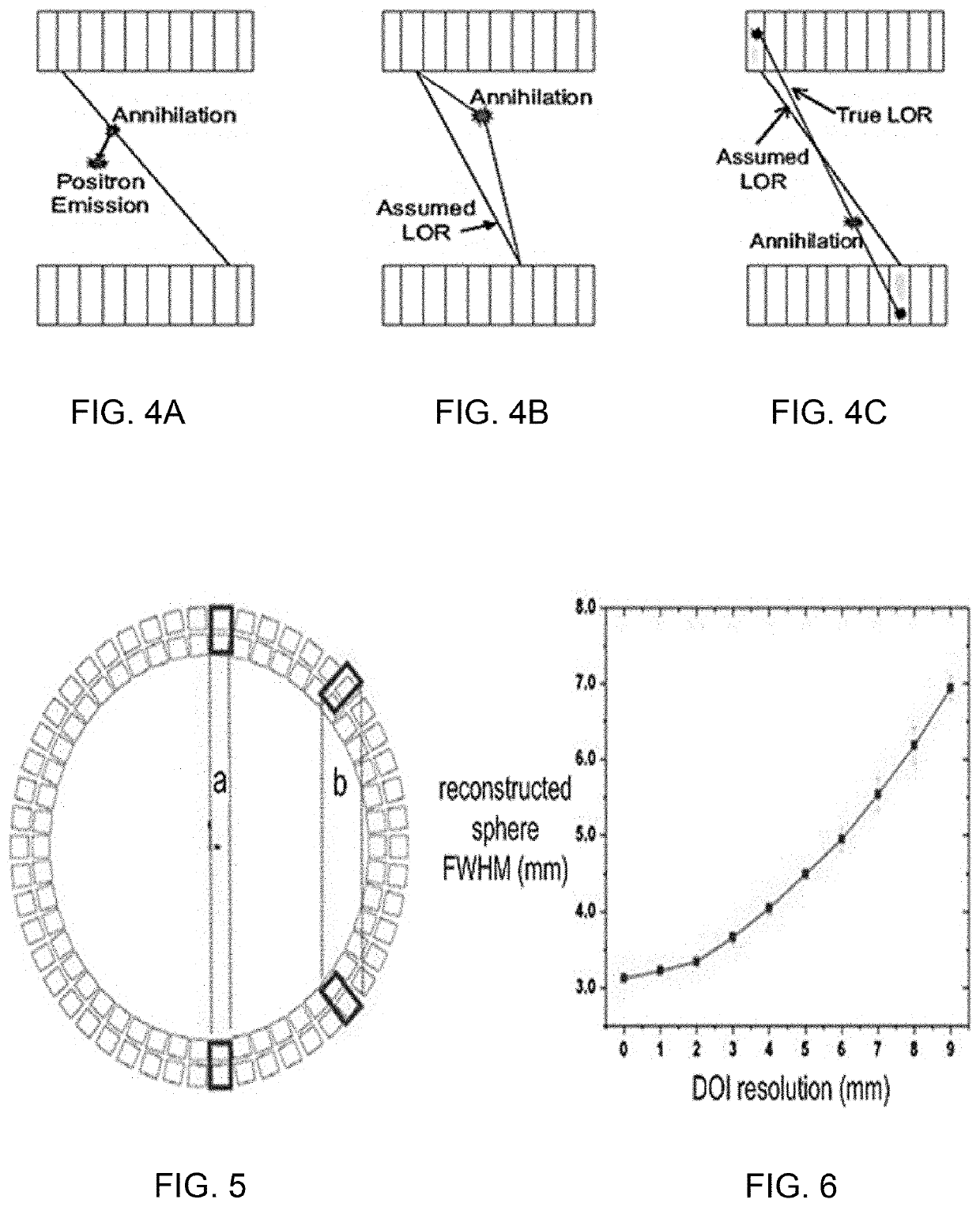Scintillation detector based systems and methods for using the same
- Summary
- Abstract
- Description
- Claims
- Application Information
AI Technical Summary
Benefits of technology
Problems solved by technology
Method used
Image
Examples
example 1
[0094]An analysis of side readouts of monolithic scintillation crystals. A method of using the side surfaces of a thin monolithic scintillation crystal for reading out scintillation photons is described. A Monte-Carlo simulation was carried out for an LYSO crystal of 50.8 mm×50.8 mm×3 mm with five silicon photomultipliers attached on each of the four side surfaces. With 511 keV gamma-rays, X-Y spatial resolution of 2.10 mm was predicted with an energy resolution of 9%. The addition of optical barriers was also explored to improve the X-Y spatial resolution. An X-Y spatial resolution of 786 μm was predicted with an energy resolution of 9.2%. Multiple layers may be stacked together and readout channels may be combined. Depth of interaction information (DOI) may be directly read out. This method provides an attractive detector module design for positron emission tomography (PET).
[0095]FIG. 13 illustrates a scintillation event 1301 (or equivalently, a gamma-ray interaction event) within...
example 2
[0126]Simulation of a CsI / LYSO Detector Layer. This section describes simulation of crystals that that were tested experimentally. The geometry of the scintillation crystal was set as 27.4 mm×27.4 mm×3 mm. Sixteen SiPMs were attached to the edges of the scintillation crystal with 4 SiPMs on each edge. Several factors influencing the spatial resolution were studied:[0127]gamma-ray photon energy and scintillator material (662 keV for CsI(Tl) vs 511 keV for LYSO);[0128]optical barriers (with / without);[0129]optical-gel & SiPM-window refractive indices (1.5 vs 1.82).
[0130]The dark-count rate was set to 2 MHz / SiPM in accordance with the Hamamatsu S13360-6050PE MPPC data sheet. The readout shaping time was set to 4 μs for CsI(Tl) and 150 ns for LYSO, based on their published decay times (Mao R, Zhang L, Zhu, R. Optical and Scintillation Properties of Inorganic Scintillators in High Energy Physics. IEEE Transactions on Nuclear Science. 2008; 55(4): 2425-2431). The optical-gel / SiPM-window ma...
experimental verification
[0132]FIG. 40 includes photographs of components of a prototype detector 4001 and 4002. The prototype detector includes the following components, labelled (a) through (e) in FIG. 40:[0133](a) Sixteen Hamamatsu S13360-6050PE MPPCs (SiPMs);[0134](b) CsI(Tl) scintillation crystal: CsI(Tl) crystal of dimension 27.4 mm×27.4 mm×3 mm (obtained from Proteus, without mechanical holes as in detector 4001, and with mechanical holes, as in detector 4002);[0135](c) pre-amplifier circuit;[0136](d) amplifier and analog-to-digital-converting circuit;[0137](e) FPGA data acquisition circuit (AiT 16-channel-readout circuit).[0138]The photograph labelled (f) is prototype detector 4001 or 4002.
[0139]The scintillator was chosen to be CsI(Tl) for convenience (no background activity from the crystal and low hygroscopicity). The MDRFs were acquired by scanning the detector with a crossed-slit-collimated beam of 662 keV photons from a 137Cs source. The beam size on the detector surface was measured to be abo...
PUM
 Login to View More
Login to View More Abstract
Description
Claims
Application Information
 Login to View More
Login to View More - R&D
- Intellectual Property
- Life Sciences
- Materials
- Tech Scout
- Unparalleled Data Quality
- Higher Quality Content
- 60% Fewer Hallucinations
Browse by: Latest US Patents, China's latest patents, Technical Efficacy Thesaurus, Application Domain, Technology Topic, Popular Technical Reports.
© 2025 PatSnap. All rights reserved.Legal|Privacy policy|Modern Slavery Act Transparency Statement|Sitemap|About US| Contact US: help@patsnap.com



